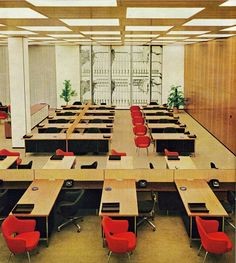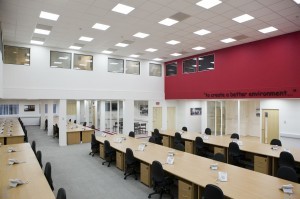Moving, or changing offices by and large, is usually not very much fun. In business it entails gathering up all your stuff, putting it into standard moving boxes, which are not much more than over-sized, glorified shoe boxes, and going somewhere else. It can be in the same building or across the country. You are essentially out of commission from the time you start putting your stuff into the boxes, until the time that you have taken it out and reconnected to the network. It adds stress to an already crowded calendar.
Long ago, when I first joined the corporate world, I read that on average you moved or changed offices every two to three years. I actually tried to look up this article to properly cite it, but, alas I couldn’t find it. Perhaps it has passed from fact, to just something that everyone knows.
You either changed roles, or business units, or assignments, or were promoted, or any number of other events that resulted in you having a new place to sit while doing your job. This was back in the days when you came into the office to work. Everybody came to the office to work. Working at home wasn’t so much of an option then.
The idea back then was to generate synergy in an organization by having groups of similarly focused individuals sit together and regularly interact in the expectation that they would be more efficient, creative and powerful as a group then they would be as discrete individuals. It seemed to work, at least back then.
I think a lot of this idea was based on the sports analogy where it was demonstrated that having all members of the same team, working together and running the same plays, were far more effective than if they all acted as just talented individuals and did what each thought was best. It was widely accepted that the best teams won, not necessarily those that just had the most talented athletes. However, I think it was Roy Williams, the basketball coach at the University of North Carolina, who said: “I can coach them to play better basketball. I can’t coach them to be seven feet tall.” So, talented athletes are still very desirable.
There were many positives and some negatives associated with this co-located and hence almost constant office moving phenomenon, for both the individual and the business. As I said earlier there is a disruption to your ability to execute your responsibilities while you are moving. This affects your, and those that are dependent on your productivity. At least for a while. This was and, in some instances, still is debatable based on some roles and activities that I have seen.
On the business side there is the cost. There are two basic costs associated with all this moving. The lost productivity that I have already noted, and the cost of the team and staff of resources that were constantly planning and executing these moves. Depending on the size of the business location, there had to be a small army of people available to bring boxes, and then move and transport boxes to the new location. There had to be a logistics team working with the Information technology team to make sure that connectivity and communications were available, at the appropriate time at the new office (or cube) location.
Moving was not cheap. Therefore, it was expected that the synergy that co-location generated had to be good enough to offset this cost. For the most part it seemed that it was.
Another good thing about moving was that it presented the opportunity to go through your stuff, take stock of what you needed and throw away all the rest. It was sort of a forced purging opportunity. As an aside, I have a friend who used to take pride in the thirty to forty boxes of stuff that he took with him whenever he moved. He is an engineer and believes that there will come a day when he will need some of the documents or calculations that he has created over the last decade plus for something else he may be working on.
It hasn’t happened yet, but I am sure he will be prepared. Like I said, engineer.
The periodic purging associated with a move was the opportunity to get rid of stuff, primarily paper-based communications and documentation, when it was no longer needed. I have hit the point that if I haven’t looked at something in the last year or two, then I don’t need it. I think this is probably a good rule of thumb for everyone. Also, with the increase in machine and cloud storage capabilities, a hard copy of just about anything can seem to be a little bit of overkill.
You don’t know how much it pains me to say that. But just as I have had to change with the times and move from the tactical joy reading of actual physical books to using an e-reader, I have gone to reading a screen instead of printing a document. And they said that dinosaurs couldn’t evolve.
Organizations have also done their part in trying to reduce the costs associated with moving. Initially they started limiting the number of boxes that you could have / they would move. Now as we continue to move toward more and more of an “open office” concept, where no one has a defined office, there is also the requisite limitation on the amount of stuff that you can have based on what has now become a limitation on the amount of physical storage that is available.
If you don’t have any place to put it or store it, then you are forced to get rid of it.
The result is that what used to happen every two to three years, and cost both the individual and the corporation a lot of money in employee discomfort and lost productivity, as well as the maintenance of a staff the size of a small army to assist in making these moves, are now both essentially gone. In the open office environment there is no defined office to move either from or to. Storage for the physical accoutrements of an office have been so minimized, and document retention has now been virtualized that there is no longer any significant amount that ever needs to be moved.
The office itself has also been virtualized. There are now both remote offices and home offices in addition to the open offices. It seems now that if you want to keep any “stuff” you will probably have to keep it in your home office. I tried this once. Then my wife complained about all my clutter. I told her it was what I needed to captain industry. She told me to get rid of it.
I personally think she was in cahoots with the corporate Workplace Resources group in this regard. Though, admittedly the home office does look cleaner.
But, I can’t help but wonder, if businesses saw such a value in the concept of having everybody actually physically work together, to the point that it outweighed the costs associated with making sure that they could work together, what happened to that value? Economics teaches us that there is no free lunch. The cost – benefit analysis of business is based on the same principles. There is a cost or investment for every benefit you get.
Has someone, somewhere gone through the analysis associated with virtual / home / open offices and compared the hard, recognizable cost savings with the somewhat softer and much harder to quantify lost synergy values. In the past it was believed that the synergies outweighed the costs. Was everyone wrong for so long and now those ideas no longer hold true?
I think the answer lies in the “hard” cost and “soft” value equation that I mentioned earlier. It is easy to define how much is saved when most of the costs associated with moving offices are eliminated. It is a number. It exists in a budget. When it is reduced or cut, it can be tracked.
The same cannot be said for the values generated by having people work together in the same office as opposed to “virtually”. I think everyone believes there is a value associated with that type of working environment, but I is almost impossible to quantitatively put a hard number to that value.
You can estimate it, but that is never as good as a well-defined cost reduction. The result is that a definable cost has been reduced, and an undefinable value has also been reduced. But since the value was undefinable in the first place, the amount of reduction to it is also undefinable.
I really didn’t like moving offices all those times that I had to do it in the past. I think that we are going to dislike what we may have lost by not having to move anymore.


